New oak-framed garage: ventilation vs. dehumidification
Discussion
Hi all,
This year I achieved a long standing ambition and built a double garage in the grounds of my house. It's about 6m square, with feather board cladding, and no insulation beyond the usual roof skin underneath the tiles - I don't have a requirement for it to keep particularly warm.
There are double doors also of timber which hinge outwards as the pic shows. One thing that has suprised me is how damp it has got in there since summer ended (construction finished in September). I have found traces of mould on the dash of my Elise, and a tray of bolts has gone completely rusty.
I have a small dehumidifier doing its best but it's really more suited to a small bathroom. Furthermore after some research on PH I realise that as there is a 1cm gap under the doors, essentially I am attempting to dehumidify the county rather than my garage.
Should I a) seal up the doors somehow and get a much bigger dehumidifer or b) put a couple of air vents in (pic also shown below).
All thoughts welcome.
Cheers.

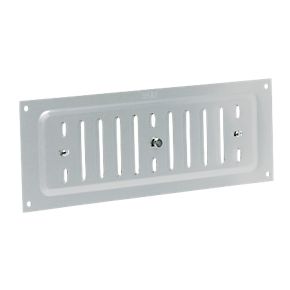
This year I achieved a long standing ambition and built a double garage in the grounds of my house. It's about 6m square, with feather board cladding, and no insulation beyond the usual roof skin underneath the tiles - I don't have a requirement for it to keep particularly warm.
There are double doors also of timber which hinge outwards as the pic shows. One thing that has suprised me is how damp it has got in there since summer ended (construction finished in September). I have found traces of mould on the dash of my Elise, and a tray of bolts has gone completely rusty.
I have a small dehumidifier doing its best but it's really more suited to a small bathroom. Furthermore after some research on PH I realise that as there is a 1cm gap under the doors, essentially I am attempting to dehumidify the county rather than my garage.
Should I a) seal up the doors somehow and get a much bigger dehumidifer or b) put a couple of air vents in (pic also shown below).
All thoughts welcome.
Cheers.


In any of the colder months, ventilation may assist but will never gaurantee protection against mould as it will be over 90% rh most of the time.
A small (in the scheme of things) wall mounted dehumidifier that is designed for an unheated space will cost you about £800 and running costs will be less than £100 a year of you add some brush seals under the door.
PM if you want to specify something and I can contact you from the office
A small (in the scheme of things) wall mounted dehumidifier that is designed for an unheated space will cost you about £800 and running costs will be less than £100 a year of you add some brush seals under the door.
PM if you want to specify something and I can contact you from the office
I've tried many things and my conclusion is that a decent sized dehumidifier is the only reasonable solution.
Another option would be to buy something like a Carcoon Veloce and place your in it. That would reduce your running costs because you only need to dehumidify the air inside the "bubble" but it comes with other downsides. I used this method for a while untll the dehumidifer's hygrostat failed and consequently dried the air down to 15% RH for weeks which completely ruined all rubber of the classic car parked in there. Fortunately it was a cheap rallye shed.
Another option would be to buy something like a Carcoon Veloce and place your in it. That would reduce your running costs because you only need to dehumidify the air inside the "bubble" but it comes with other downsides. I used this method for a while untll the dehumidifer's hygrostat failed and consequently dried the air down to 15% RH for weeks which completely ruined all rubber of the classic car parked in there. Fortunately it was a cheap rallye shed.

Not sure if it will help but I have a 6 car timber garage built by the PO like a large shed - shiplap walls and ply roof with felt on top.
I have no damp issues - I've stored beds, books and clothing alongside cars during my refurb and I was surprised there's no mould anywhere, nor is there any vents, dehumidifier etc.
The stuff stored in my Dad's steel agricultural building which is well ventilated (but condenses terribly) has loads of mould.
I have no damp issues - I've stored beds, books and clothing alongside cars during my refurb and I was surprised there's no mould anywhere, nor is there any vents, dehumidifier etc.
The stuff stored in my Dad's steel agricultural building which is well ventilated (but condenses terribly) has loads of mould.
Don't worry about a dehumidifier in a space like that - too much leakage around doors and through the cladding to deal with.
Put some high level vents into the roof or gable walls (if it has any) and that should help a lot.
There will also be a lot of water in the oak frame elements which will make the problem worse for the first few years as they dry out. After a few years things should settle down a bit.
Put some high level vents into the roof or gable walls (if it has any) and that should help a lot.
There will also be a lot of water in the oak frame elements which will make the problem worse for the first few years as they dry out. After a few years things should settle down a bit.
jason61c said:
what membrane is it? One of the selling points of these garages is how they moderate the dew point, you shouldn't be getting any type of issues. what sort of ridge system is fitted? A decent modern dry ridge system?
I have no idea I'm afraid Jason. I will ask the company that built it (Crown oak buildings in Edenbridge). They have done hundreds of these so hopefully they've done everything right. JD said:
In any of the colder months, ventilation may assist but will never gaurantee protection against mould as it will be over 90% rh most of the time.
A small (in the scheme of things) wall mounted dehumidifier that is designed for an unheated space will cost you about £800 and running costs will be less than £100 a year of you add some brush seals under the door.
PM if you want to specify something and I can contact you from the office
Nooooo, this is tech over thought, over common sense. A small (in the scheme of things) wall mounted dehumidifier that is designed for an unheated space will cost you about £800 and running costs will be less than £100 a year of you add some brush seals under the door.
PM if you want to specify something and I can contact you from the office
I built a 7.5 x 4 Mtr 'garage'. Softwood timber framed with an exterior ship lap softwood t&g boarded, chipboard internal walls with fibreglass insulation. 3 x extremely small non opening windows (security measure), concrete floor with DPM and metal corrugated insulated roof. 1 x side door and pair of large openings to get the car in and out.
However, 1 x £80 wall mounted 2.5kw heater (on timer) and a good 10mm gap under doors (and they ar not draft proofed) . Basically the garage is warmed, dries out most of any damp and the rest if any can escape. That's all I have and it works a treat. Finally I bought off eBay some moisture sucking plastic things (5 for a tenner) and left them in the garage for belt and braces over the winter, and they collected less that 2 pints of water over 4 months..
It even stores a load of my wifes belongings (we are renovating) and everything from blankets to curtains are stored in it and they are fine.
No mould no rust in car. In six years. Ventilation and/or gentle Heat are your friends here. I know of many people with serious car collections, and I have never seen one yet use a dehumidifier.
Edited by Wozy68 on Sunday 3rd January 22:47
Assuming the membrane is right..... that's an identical construction to my garage.
I have a dehumidifier running 24/7 and don't have any issues - and I've been keeping some nice cars in good condition over the years.
Keeping some air circulating is always good and the drafts through the doors will be good for this. Some trays of mouse poison are a good idea too along the walls.... mice get in under the doors and poison trays are 100% effective in my experience.
I tried something called 'garage dry' a few years ago (they're out of business now) which was a sort of heated fan affair - didn't do any good.
I have a dehumidifier running 24/7 and don't have any issues - and I've been keeping some nice cars in good condition over the years.
Keeping some air circulating is always good and the drafts through the doors will be good for this. Some trays of mouse poison are a good idea too along the walls.... mice get in under the doors and poison trays are 100% effective in my experience.
I tried something called 'garage dry' a few years ago (they're out of business now) which was a sort of heated fan affair - didn't do any good.
Wozy68 said:
Nooooo, this is tech over thought, over common sense.
I built a 7.5 x 4 Mtr 'garage'. Softwood timber framed with an exterior ship lap softwood t&g boarded, chipboard internal walls with fibreglass insulation. 3 x extremely small non opening windows (security measure), concrete floor with DPM and metal corrugated insulated roof. 1 x side door and pair of large openings to get the car in and out.
However, 1 x £80 wall mounted 2.5kw heater (on timer) and a good 10mm gap under doors (and they ar not draft proofed) . Basically the garage is warmed, dries out most of any damp and the rest if any can escape. That's all I have and it works a treat. Finally I bought off eBay some moisture sucking plastic things (5 for a tenner) and left them in the garage for belt and braces over the winter, and they collected less that 2 pints of water over 4 months..
It even stores a load of my wifes belongings (we are renovating) and everything from blankets to curtains are stored in it and they are fine.
No mould no rust in car. In six years. Ventilation and/or gentle Heat are your friends here. I know of many people with serious car collections, and I have never seen one yet use a dehumidifier.
It is not overthought in the slightest; common sense would dictate you want to maintain the space with the lowest running costs possible and electric heating and ventilation is not efficient when compared to dehumidification.I built a 7.5 x 4 Mtr 'garage'. Softwood timber framed with an exterior ship lap softwood t&g boarded, chipboard internal walls with fibreglass insulation. 3 x extremely small non opening windows (security measure), concrete floor with DPM and metal corrugated insulated roof. 1 x side door and pair of large openings to get the car in and out.
However, 1 x £80 wall mounted 2.5kw heater (on timer) and a good 10mm gap under doors (and they ar not draft proofed) . Basically the garage is warmed, dries out most of any damp and the rest if any can escape. That's all I have and it works a treat. Finally I bought off eBay some moisture sucking plastic things (5 for a tenner) and left them in the garage for belt and braces over the winter, and they collected less that 2 pints of water over 4 months..
It even stores a load of my wifes belongings (we are renovating) and everything from blankets to curtains are stored in it and they are fine.
No mould no rust in car. In six years. Ventilation and/or gentle Heat are your friends here. I know of many people with serious car collections, and I have never seen one yet use a dehumidifier.
Edited by Wozy68 on Sunday 3rd January 22:47
With heating, all of the energy you input into the space leaves as heat loss through the structure and the ventilation whereas with dehumidification you enclose the space as much as possible and only remove the unwanted moisture required to get the space below 60% RH.
I am sure there are many people around the country who do not have any form of dehumidification and their cars are “fine”, but in a country where the average humidity is nearly always above 60% (the magic number for rust prevention) there is a reason the technology exists, is proven and why people in the business of car storage to make money use proper dehumidification.
The technology is simple, reliable and is not expensive. People will frequently spend millions on cars, hundreds of thousands on garages, but seem to baulk at the idea of a few thousand to keep it protected as much as possible!
JD said:
It is not overthought in the slightest; common sense would dictate you want to maintain the space with the lowest running costs possible and electric heating and ventilation is not efficient when compared to dehumidification.
With heating, all of the energy you input into the space leaves as heat loss through the structure and the ventilation whereas with dehumidification you enclose the space as much as possible and only remove the unwanted moisture required to get the space below 60% RH.
I am sure there are many people around the country who do not have any form of dehumidification and their cars are “fine”, but in a country where the average humidity is nearly always above 60% (the magic number for rust prevention) there is a reason the technology exists, is proven and why people in the business of car storage to make money use proper dehumidification.
The technology is simple, reliable and is not expensive. People will frequently spend millions on cars, hundreds of thousands on garages, but seem to baulk at the idea of a few thousand to keep it protected as much as possible!
I do agree with you, I just feel that in this instant its not solving the problem, just hiding the issue. This new build garage should not be so swamped in moisture that mould is growing on his dashboard. With heating, all of the energy you input into the space leaves as heat loss through the structure and the ventilation whereas with dehumidification you enclose the space as much as possible and only remove the unwanted moisture required to get the space below 60% RH.
I am sure there are many people around the country who do not have any form of dehumidification and their cars are “fine”, but in a country where the average humidity is nearly always above 60% (the magic number for rust prevention) there is a reason the technology exists, is proven and why people in the business of car storage to make money use proper dehumidification.
The technology is simple, reliable and is not expensive. People will frequently spend millions on cars, hundreds of thousands on garages, but seem to baulk at the idea of a few thousand to keep it protected as much as possible!
This is what I meant, it should not have to require a dehmidifier here, just to rid that much moisture.

It started off being raw concrete.
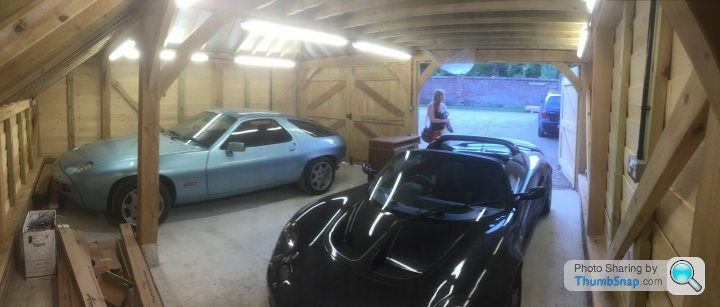
As we all know this generates a ton of dust and is not really suitable for a working building. The next step was to powerfloat a self-levelling screed compound (I think it's called Cempolay or something like that). This took 2 hardworking Bulgarian guys a day to do, the materials cost was about £500.
Now don't ask me why I didn't pay for the guys to do the next steps. Sometimes, you just have to do the work yourself for the plain old satisfaction of doing it yourself.
I hand-sanded the entire floor with something that basically looked like a housebrick with a handle. Probably the hardest day's work I've ever done! Took about 6 hours in total. Here we are about half way through.
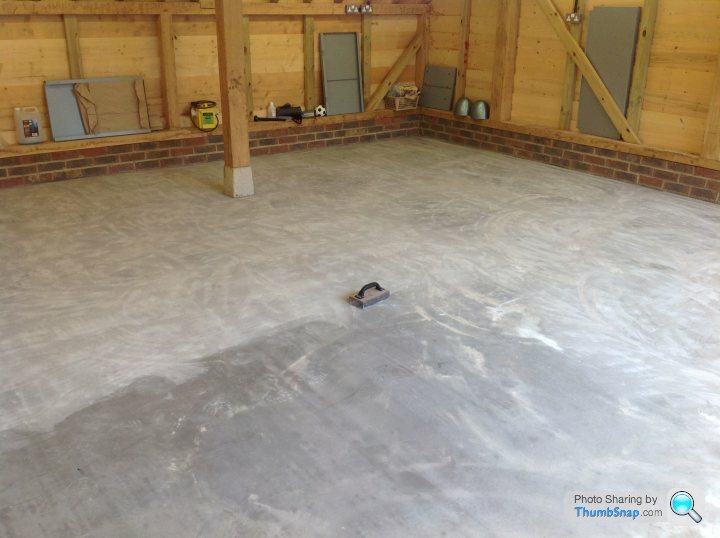
Next step was to sweep, sweep and sweep again. Then vacuum. Then a bit more sweeping. Then mop. Then mop again.

Then start painting. I spoke to Regal Paints and explained the application, and they said there was no need to go for the full epoxy resin for a home garage, even one which was going to be used heavily as a home workshop. This is the product they recommended http://www.regalfloorpaint.co.uk/product/quick-dry... . Even so it was thoroughly nasty stuff which stank to high heaven, and another day's working saw 2 coats go on.
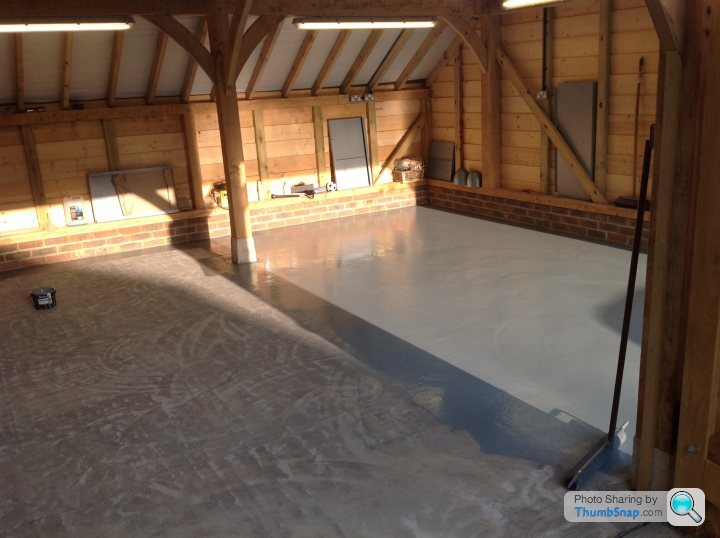
Then I could start building the Clarke workbench from Machine Mart.

The sort of thing that you think "no way can this be assembled with these instructions" but stay calm, plenty of tea and you figure it all out in the end. It wasn't cheap, over £350 from memory but it is built like a brick s thouse and will hopefully last a lifetime.
thouse and will hopefully last a lifetime.
Don't think i have a final pic of it full assembled but here we are almost done
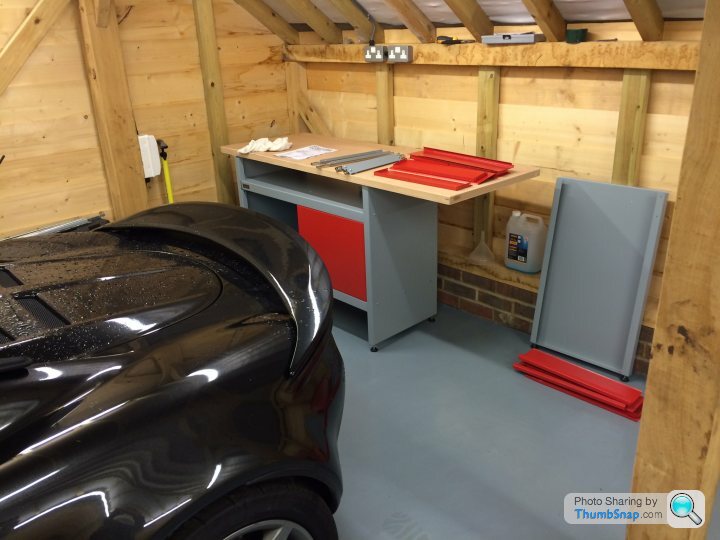
It's been great fun, and I can't tell you how nice it is to have a proper garage facility. Now I just need to solve this condensation / damp problem. I have a £5 humidity meter coming from Amazon. I'm leaning towards the dehumidification solution as I think, as someone has said, the oak is probably giving off a lot of moisture.
It feels so good being able to go and work on the cars and not have to put every last thing away and stop because it's raining!
Joel

As we all know this generates a ton of dust and is not really suitable for a working building. The next step was to powerfloat a self-levelling screed compound (I think it's called Cempolay or something like that). This took 2 hardworking Bulgarian guys a day to do, the materials cost was about £500.
Now don't ask me why I didn't pay for the guys to do the next steps. Sometimes, you just have to do the work yourself for the plain old satisfaction of doing it yourself.
I hand-sanded the entire floor with something that basically looked like a housebrick with a handle. Probably the hardest day's work I've ever done! Took about 6 hours in total. Here we are about half way through.

Next step was to sweep, sweep and sweep again. Then vacuum. Then a bit more sweeping. Then mop. Then mop again.

Then start painting. I spoke to Regal Paints and explained the application, and they said there was no need to go for the full epoxy resin for a home garage, even one which was going to be used heavily as a home workshop. This is the product they recommended http://www.regalfloorpaint.co.uk/product/quick-dry... . Even so it was thoroughly nasty stuff which stank to high heaven, and another day's working saw 2 coats go on.

Then I could start building the Clarke workbench from Machine Mart.

The sort of thing that you think "no way can this be assembled with these instructions" but stay calm, plenty of tea and you figure it all out in the end. It wasn't cheap, over £350 from memory but it is built like a brick s
 thouse and will hopefully last a lifetime.
thouse and will hopefully last a lifetime. Don't think i have a final pic of it full assembled but here we are almost done

It's been great fun, and I can't tell you how nice it is to have a proper garage facility. Now I just need to solve this condensation / damp problem. I have a £5 humidity meter coming from Amazon. I'm leaning towards the dehumidification solution as I think, as someone has said, the oak is probably giving off a lot of moisture.
It feels so good being able to go and work on the cars and not have to put every last thing away and stop because it's raining!
Joel
Edited by barchetta_boy on Monday 4th January 11:21
barchetta_boy said:
Now I just need to solve this condensation / damp problem. I have a £5 humidity meter coming from Amazon. I'm leaning towards the dehumidification solution as I think, as someone has said, the oak is probably giving off a lot of moisture.
Have you spoken to the manufacturer? If I'd paid £20K plus for a garage and it had a condensation problem I'd want to know why; if I were the manufacturer I'd want to know as well. Oak won't give off much moisture at all; it will have had a reasonable amount of seasoning before it was cut to size otherwise every oak garage would be warped after a couple of years and that's not the case. As a last resort install gable vents fairly high up but eaves/ridge/breathable sarking felt should have been included in the design and I would expect the manufacturer to send someone round to see exactly what has been constructed for your garage and why you have this problem.Gassing Station | Homes, Gardens and DIY | Top of Page | What's New | My Stuff



